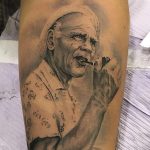
Tattoos have a history that is centuries old, with mummified remains being found with tattoos. In fact, Otzi, the oldest mummy found with tattoos (61!), was discovered in glacial ice in the alps and dated to 3,250 BC. The word tattoo is from the Polynesian word “tatau,” which means “to write.”
In the United States, German immigrant Martin Hildebrandt opened in the first tattoo shop in the U.S. in New York City in 1846. His tattoos became popular with soldiers during the American Civil War. Soon, Hildebrandt was traveling to camps to tattoo soldiers ? and creating the American tradition of getting tattoos while in the military.
Since the 1970s, tattoos have been part of mainstream fashion. So, we’ve decided to take a look at tattoos in this month’s style issue ? their meanings, their art and, sometimes, the medical reasons behind them.
GET A GOOD TATTOO / Demet SENTURK
There is an old saying about tattoos: “Cheap tattoos aren’t good, and good tattoos aren’t cheap.”
Throughout my conversation with Steven Atkins, a tattoo artist based in Worcester, this old saying was emphasized. Atkins has corrected many bad tattoos in his time. He said the original cost of the tattoo, if done well in the first place, would have been less than the total cost of getting a bad one and correcting it.
The high cost of tattoos has to do with the high cost of supplies, which tattoo artists pay for out of pocket. Atkins said that 40 percent of the cost of each tattoo he does is used for equipment and supplies. It is also considered medical malpractice in Massachusetts to give a tattoo if you are not certified. In order to avoid damaging your skin and wanting to get rid of your tattoo just a few years after you’ve gotten it, Atkins offered a few tips:
- Come prepared – know what you’re getting yourself into.
- Be original.
- Do not follow trends – trends last only a few years, and you don’t want something that you will end up regretting in the future.
- Do not get a tattoo in the summer, especially if you are burnt!
When Atkins got his very first tattoo, he drew his own. Everyone is different. He said some people will bring him a trend but ask him to revise it so that it’s unique. Speaking of which, one of Steve’s lotus designs made it to the Internet, and now, many people are requesting it. There is always going to be a trend, and it’s always going to come back ? like bellbottoms. Mandalas are very trendy today but might not be as popular 10 years from now. Trends come and go, but originality stays. The chances of covering an original tattoo are slim to none, so let your creativity speak!
THE RISE OF MEDICAL TATTOOS / Rosemarie ANDLAUER
Medical tattooing is a relatively new term. It means tattooing that’s done for medical purposes, as opposed to picture tattoos. The most common form of medical tattoo is nipples. On women that have had breast cancer, we create the illusion of a 3D nipple with tattooing. Women that have had breast lifts can sometimes heal with a lot of scaring on or around the nipple or with a misshaped nipple. In this case, tattooing is used to reshape the nipple and cover the scars. Men and women that have unusually small nipples may get them tattooed to appear larger.
Scar cover is another form medical tattooing. These can be surgical scars, accident scars and stretch marks. It can be reshaping the upper lip in someone that was born with cleft lip or color-blending on areas of skin that have color discrepancies. Also for people that have alopecia, which is common after many cancer treatments, clients may choose to have the appearance of eyebrow hair tattooed or an eyelash enhancement to give the appearance of eyelashes.
Medical tattooing is a specialty and should only be done by someone certified as a medical tattoo artist. The areas that medical tattoos are done on have often been through much trauma and can react very differently than unharmed skin. Such areas need to be dealt with differently than a regular picture tattoo. There are not a lot of medical tattoo artists, but it is becoming a much more common form of tattooing. It’s worth looking for a specialist if you are considering a medical tattoo.
Rosemarie Andlauer is the CEO of Miraculous Creations, 387 Park Ave., Worcester. For more on medical tattooing, visit miraculouscreations.com.
IF YOU’VE MADE A MISTAKE… / Nicole LUPARELLI
Before you get that tattoo, make sure it’s something you can live with for at least a few years. While laser tattoo removal is available, it’s not the instant result many people with tattoo regret think. Laser tattoo removal is a long, painful road. But, if your tattoo says Melissa and you’re married to Jennifer, it may be the road for you.
Tattoo removal can take anywhere from five to 20 treatments, depending on the ink used (it’s not FDA regulated), placement on the body (feet, ankles and lower back can all take more sessions, for example), ink color (turquoise and yellow are some of the hardest colors to remove), skin type, immune system, age, depth of ink and your activity level (Do you run? Do you sit on the couch and smoke cigarettes?). All these factors and more can affect your tattoo removal journey.
Another misconception is that the laser itself is what removes the ink. In tattoo removal, the laser passes over the ink, breaking the ink into fragments. Imagine your tattoo is a stack of dishes, with every layer of ink a different plate. The laser essentially breaks the top dish as if you dropped it on the floor. Some pieces are big, some small. The smallest pieces get absorbed by your body’s scavenger cells (macrophages) and pass through your immune system. The larger pieces will need to be hit again at the next session. Rinse and repeat, until your tattoo is gone or you’re light enough for a cover-up.
You can also think of your tattoo as a giant boulder of ink. We chip away at it with the laser, bit by bit, like a little pickax. Then, your scavenger cells are like the janitors that sweep away the rubble. This is what takes all the time. The size of the tattoo does not matter as much as how many layers of ink are present. Tattoo removal sessions are spaced every six to eight weeks apart. Unlike laser hair removal, the longer you wait in between laser treatments, the better results you will see per treatment.
The procedure itself is very fast and generally feels like a cross between a rubber band snapping and cooking bacon naked. Common side effects include swelling, redness, blistering and itchiness. Scarring is extremely rare. If waiting for full removal is not going to cut it, you can also use the laser to lighten the tattoo for a cover-up. In about three to six sessions, on average, you would be able to get a cover-up over the lightened tattoo that’s not an enormous blackout. It’s always a good idea to check in with your tattoo artist first to see what they have in mind for your cover-up and how light they need your original tattoo to be.
The most popular tattoos we see for removal are: Names, wedding rings (next time get the jewelry), tribals and lower back tattoos.
Ultimately, be mindful of your body modifications, people. Tattoo removal can cost 10 times what you paid for your original tattoo. They’re meant to be permanent.
Nicole Luparelli owns Worcester Tattoo Removal, 101 Pleasant St., Suite 112, Worcester. For more information on tattoo removal, visit worcestertattooremoval.com.
FAVORITES
Tattoos mean many things to many people. Here, readers and artists talk about their favorite tattoos.
This is my statue of David tattoo by Fred Flores. I got this piece because I’ve always been enthralled by all of Michaelangelo’s work. The statue of David is, in my opinion, the most beautiful sculpture in the world. I love the story and the meaning behind this amazing piece of art.
? Nicholas Patchen, Worcester
“She flies with her own wings”
I’m no longer held captive by the expectations of society. I’m independent & strong. I’m no longer emotionally dependent on anyone for my own happiness.
The arrow: Direction. My life continuing to move forward and grow through the obstacles I’ve overcome.
The feather: Freedom. The life I want for myself and my children.
? Danielle Torrey, Worcester
I got this tattoo after my father passed away. I inevitably became the man of the house. I had to grow up quick. It represents the light at the end of the tunnel. Even though I couldn’t see the light at times, I knew… There will be light.
? Michael Lawlor, Worcester
With this “whimsical” arm sleeve, I obviously had a lot of creative freedom with color and layout, a laid-back client with great ideas and input, etc, but what might not be obvious is that the work is covering a good amount of scarring. With my work, I was able to transform something she didn’t initially love into artwork she now shows off and is very proud of. To be able to do that made me proud of my trade and made this piece “memorable” to me.
? Eamon Gillen, Crown of Thorns Tattoo, Worcester
This is one of my personal favorite pieces that I’ve done over the years. I chose the “King Penguin” tattoo because I’m a huge lover of everything penguin. So this piece was an honor to create and incredibly fun to work on.
? Justin Buduo, Studio 31 Tattoos and Fine Art, Worcester
This portrait was of a client’s great-grandfather. It was a picture that he had grown up with and, along with stories about his great-grandfather, it inspired him to be a better man. He said his great-grandfather was a strong, self-reliant and loving husband, father and grandfather. He wanted this tattoo to remind him of those characteristics.
? Josh Torres, Piercing Emporium and Tattoo, Worcester
I get asked if I have a favorite tattoo a lot. My answer isn’t very interesting, even a bit cliche. I don’t have a favorite. I make sure that I am excited about the artwork before I begin each tattoo. So I really do just love them all.
? Nate Euvrard, UV Tattoo, Leominster
















